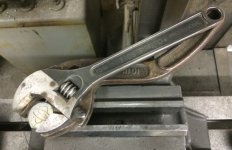Modern Wrenches and Their Antecedents - Scientific American
History of the wrench - 1835 Wrench
The US was once full of clever young (mostly) men trying to earn their fortune with a mechanical or tools patent. While I've heard the "to clear obstruction" explanation, I've also heard that it was somewhat a matter of happenstance and fashion.
I'd guess the S wrench went out of fashion when wrench makers learned they could make more by offering sets of tools -- and the present form of open ended wrench turned out to be more compact to pack in a kit.
We do product teardowns with young children at the local Children's Museum -- maybe ages 5-8. Local recycling group donates appliances, game consoles, stereo's, power tools, etc. that have died. The teardown sparks a bit of curiosity in many. It's also surprising to we older folks that so many don't know which way to turn a wrench or screwdriver -- and are completely baffled by explanations of clockwise and counter-clockwise. All of 'em can pull up an app on a smartphone, though.
Good news is that it isn't long before most kids can tell things like Torx from hex screws . . . and want to take some prize bit inside as part of their triumph at learning what makes things go . . .


